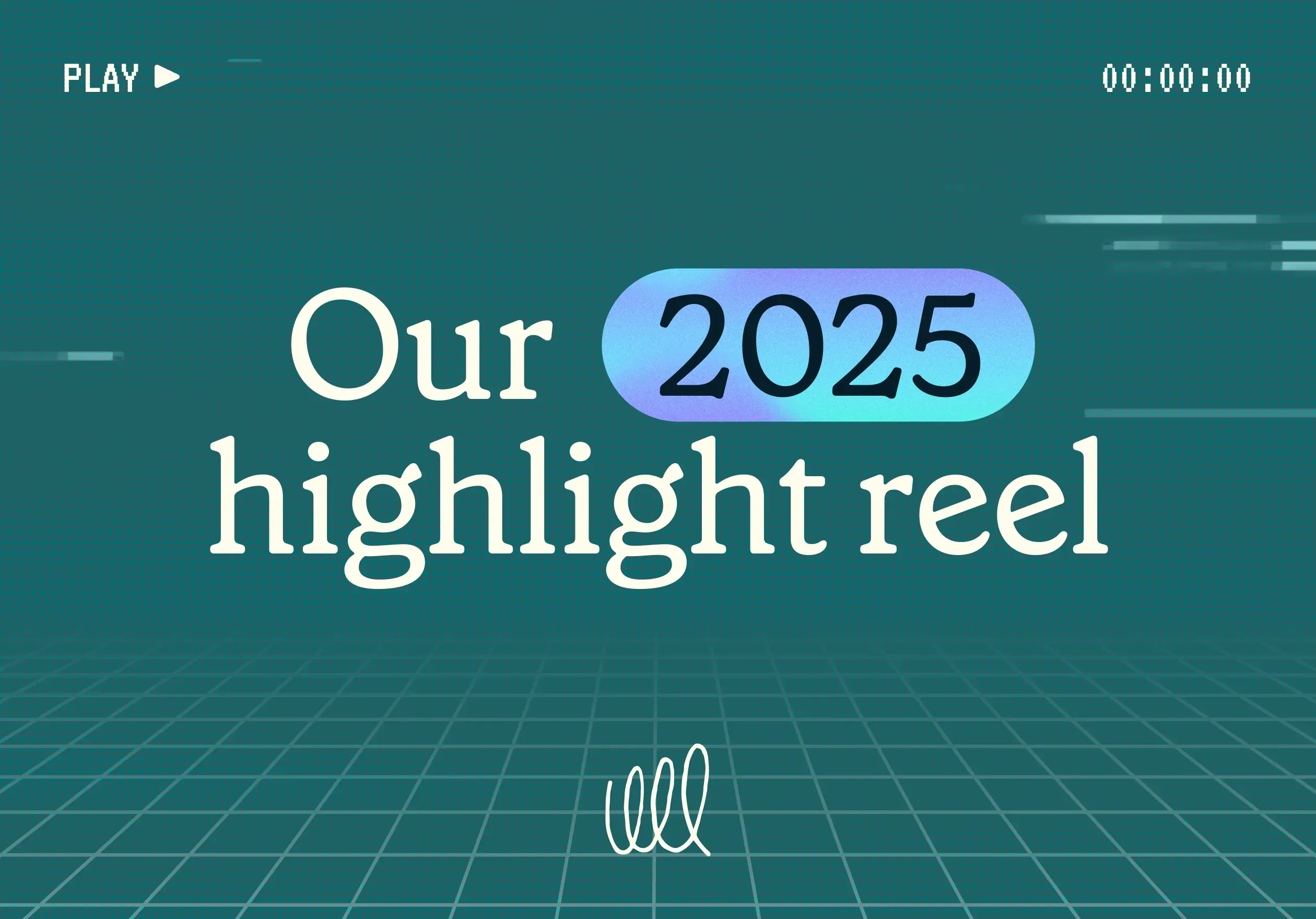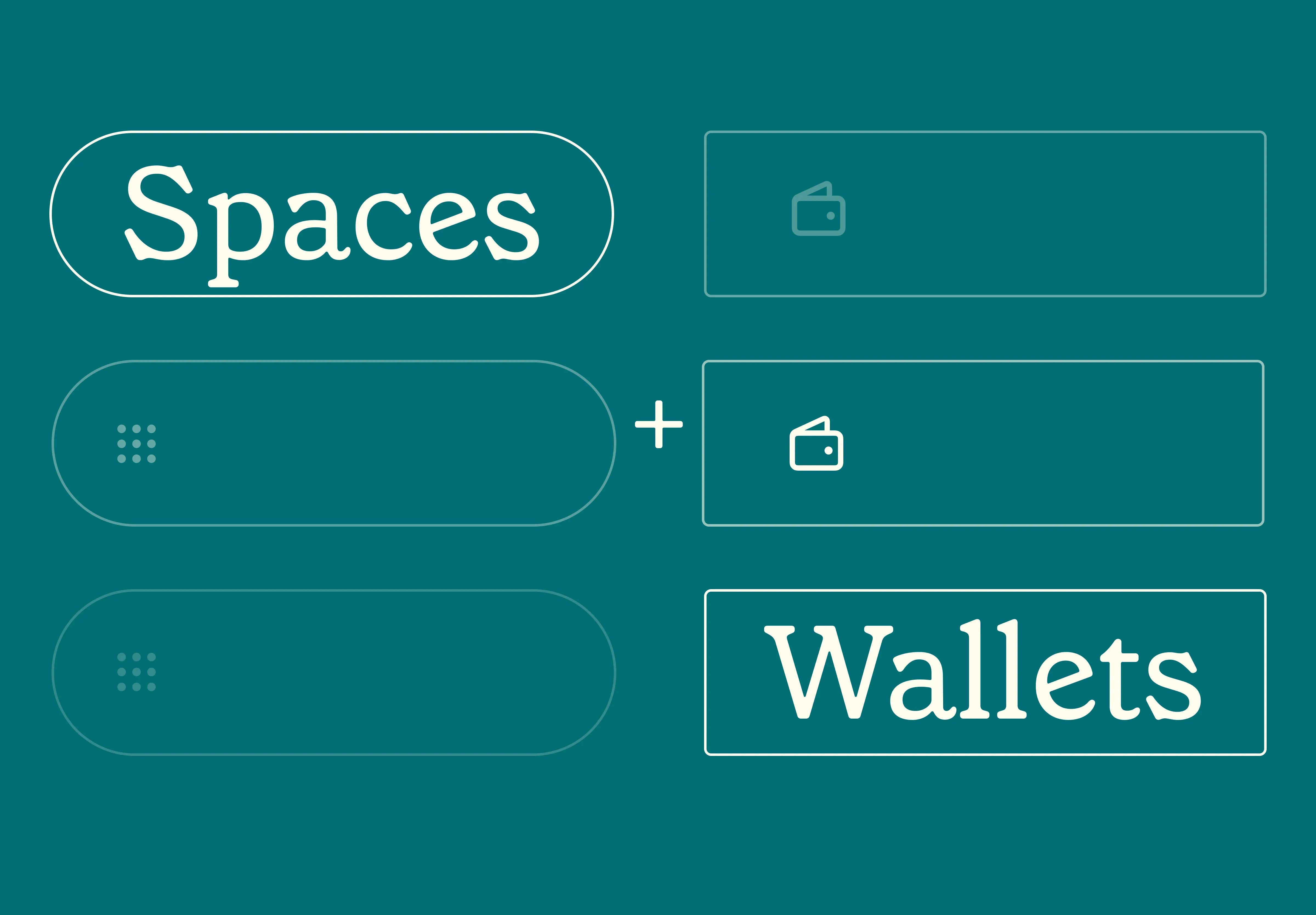14 Nov 2025
|10 min
How to write impactful prototype testing questions
Discover essential questions to ask during prototype testing to gather insightful feedback and improve your design.

Designing a prototype is an essential part of the design process. Whether you’re building a product from scratch or adding a new feature to a preexisting one, at some point you’ll need to build a working version.
Testing your prototype is an important part of this process. Having your target audience use an early version of your product can give you helpful feedback on how they use and think about it. Asking thoughtful questions is another great way to gather useful feedback.
Read on to learn more about the types of questions to ask when testing your prototypes, as well as best practices and some tried-and-true sample questions.
What is prototype testing?
Prototype testing involves creating a preliminary model of your product to simulate its functionality and test its features. The process allows you to evaluate its performance, identify design flaws, and gather user feedback.
Taking this step before moving into production can help pinpoint any potential issues early, saving you time and money. It also helps to validate the utility of the core product.
Prototype testing can help you learn from real-world users. If you’ve created a new note-taking app, for example, you might ask test participants to jot down quick notes in a variety of hypothetical situations. You can then find out how easy they found the task and any issues they encountered. This can help you figure out whether the app succeeds in its original design goals, and ultimately validate its position in the market.
Testing can also help identify granular improvements. If you’re designing a new user interface (UI) for an ecommerce platform, prototype testing may involve asking users to search for and purchase specific types of items. Doing this can help you make sure that the new UI doesn’t interfere with this core functionality. The questions you ask can turn these user experiences into invaluable feedback.
Elevate your research practice
Join over 320,000+ marketers, designers, researchers, and product leaders who use Lyssna to make data-driven decisions.
Types of prototype testing questions
Prototype testing questions come in a variety of shapes and sizes, and there’s a good chance you’ll want to ask a variety of them during your test.
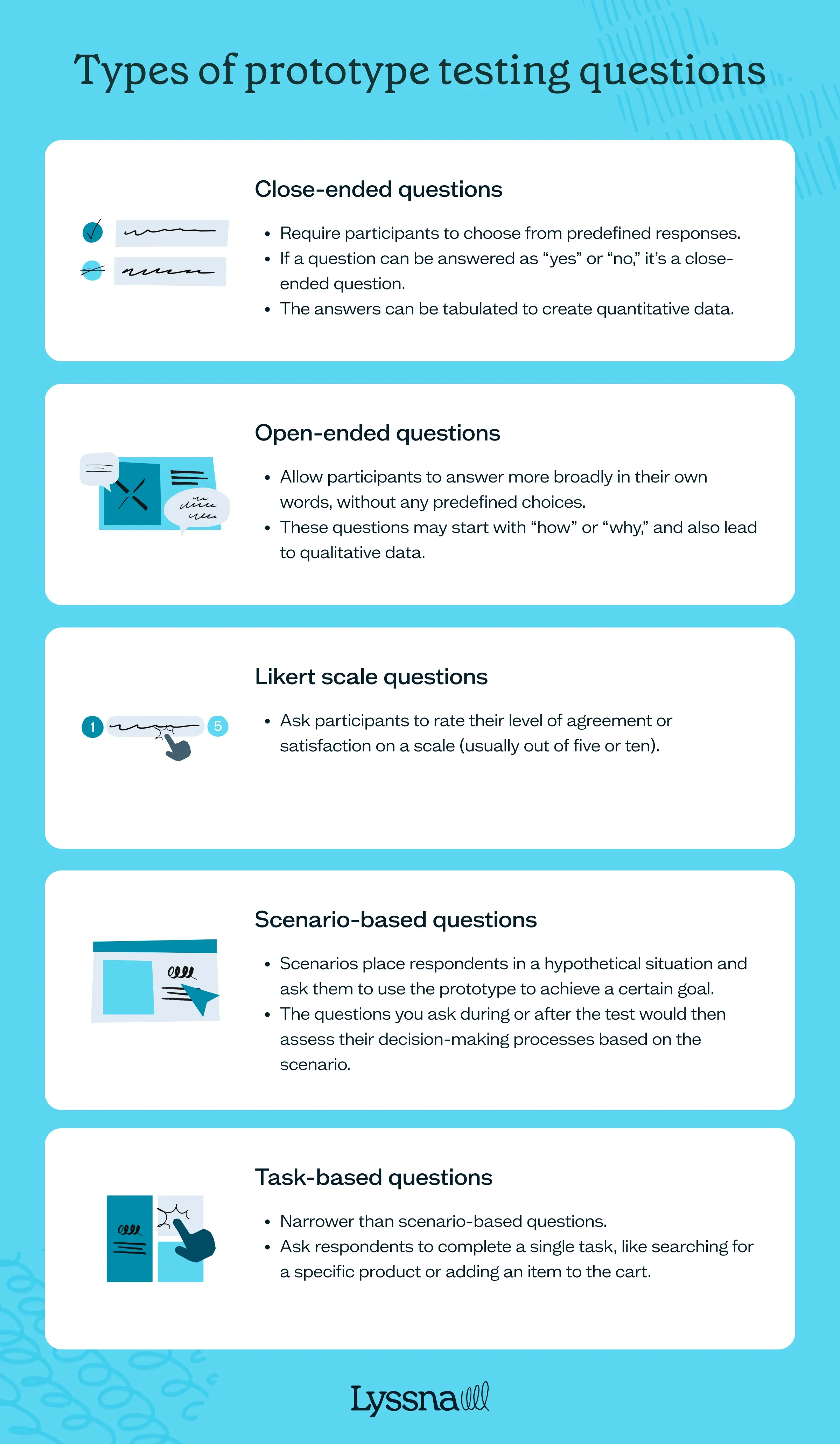
Close-ended questions
Close-ended questions require participants to choose from predefined responses. If a question can be answered as “yes” or “no,” it’s a close-ended question. The answers can be tabulated to create quantitative data.
Open-ended questions
Open-ended questions allow participants to answer more broadly in their own words, without any predefined choices. These questions may start with “how” or “why,” and also lead to qualitative data.
Likert scale questions
Likert scale questions ask participants to rate their level of agreement or satisfaction on a scale (usually out of five or ten). A classic example is the question, “How likely are you to recommend this product to a friend or colleague?”, with one being very unlikely and five being very likely.
Scenario-based questions
Scenarios place respondents in a hypothetical situation and ask them to use the prototype to achieve a certain goal. For example, a scenario may have participants planning a vacation. The questions you ask during or after the test would then assess their decision-making processes based on the scenario.
Task-based questions
Task-based questions are narrower than scenario-based questions, asking respondents to complete a single task, like searching for a specific product or adding an item to the cart.
Best practices for writing prototype testing questions
Below are some best practices you can follow when writing prototype testing questions.
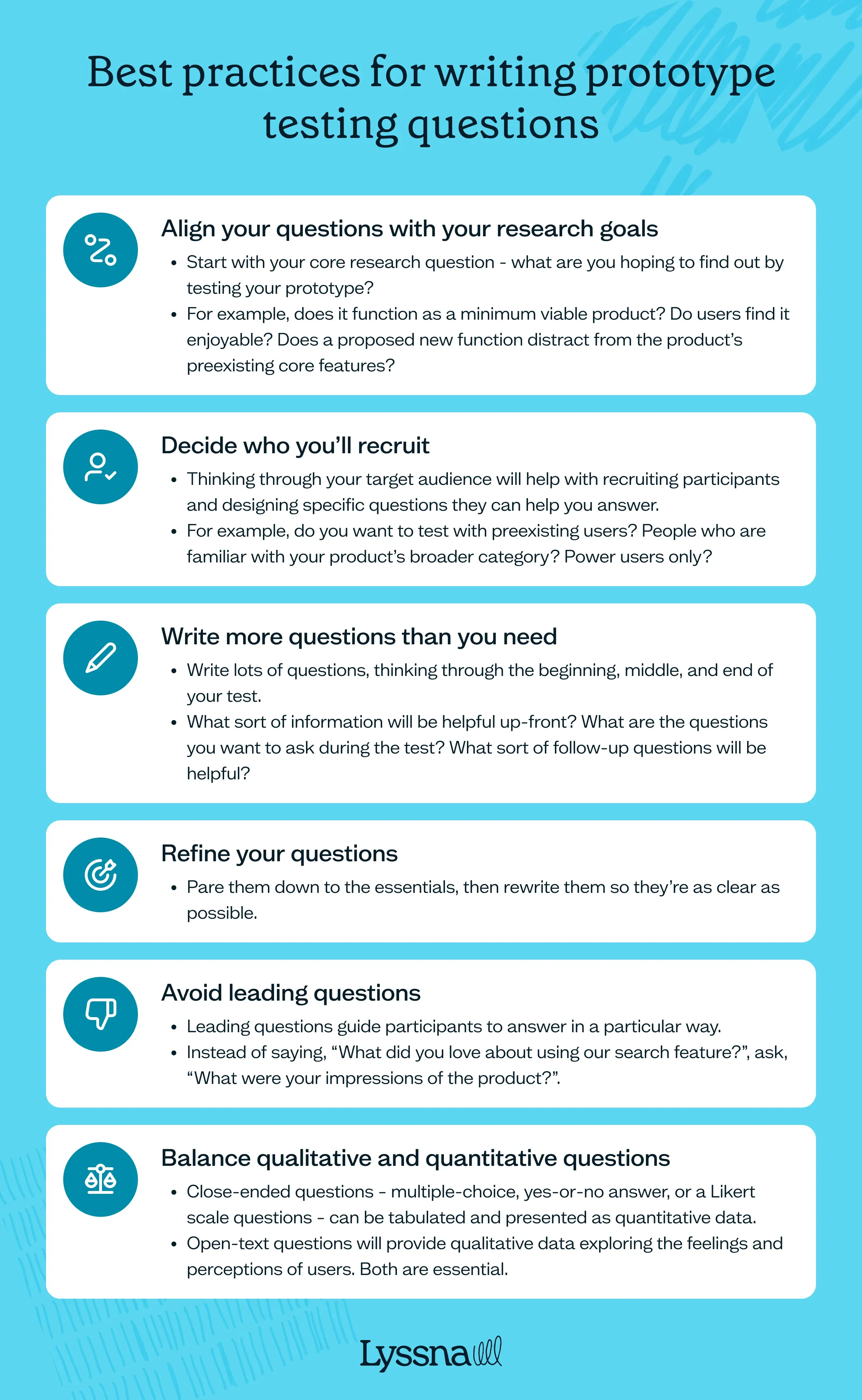
Tagging results from a test in Lyssna
Align your questions with your research goals
Start with your core research question – what are you hoping to find out by testing your prototype? For example, does it function as a minimum viable product? Do users find it enjoyable? Does a proposed new function distract from the product’s preexisting core features?
Decide who you’ll recruit
Do you want to test with preexisting users? People who are familiar with your product’s broader category? Power users only? Thinking through your target audience will help with recruiting participants and designing specific questions they can help you answer.
Write more questions than you need
Write lots of questions, thinking through the beginning, middle, and end of your test. What sort of information will be helpful up-front? What are the questions you want to ask during the test? What sort of follow-up questions will be useful? Write more questions than you need, phrasing them differently, and clustering them together in a logical sequence.
Refine your questions
Pare them down to the essentials, then rewrite them so they’re as clear as possible.
Avoid leading questions
Leading questions guide participants to answer in a particular way. Instead of saying, “What did you love about using our search feature?” ask “What were your impressions of the product?”.
Balance qualitative and quantitative questions
Close-ended questions – multiple-choice, yes-or-no answer, or a Likert scale questions – can be tabulated and presented as quantitative data. Open-text questions will provide qualitative data exploring the feelings and perceptions of users. Both are essential.
Prototype testing question examples
Prototype tests come in many forms. They can take place in-person or remotely, and can be moderated or unmoderated. Sometimes they involve many users, resulting in huge quantities of data, and other times they focus on the perceptions and opinions of a small group.
Obviously, these variables can impact the types of questions you ask. You can use the example questions below as either thought starters or to validate and fill in the blanks on your own slate of questions.
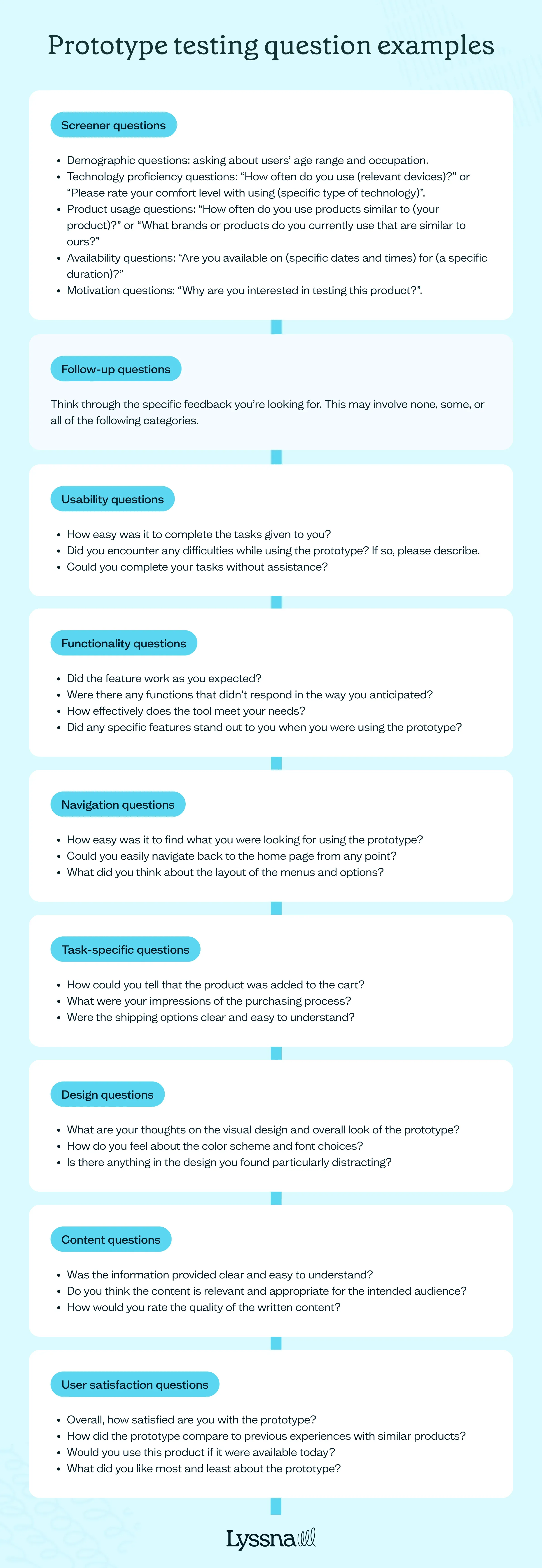
Screener questions
Before you conduct your prototype test, screener questions can help to make sure that participants are well-suited to deliver the sort of feedback you need. Consider the following:
Demographic questions, such as asking about users’ age range and occupation.
Technology proficiency questions, such as “How often do you use (relevant devices)?” or “Please rate your comfort level with using (specific type of technology)”.
Product usage questions, including “How often do you use products similar to (your product)?” and “What brands or products do you currently use that are similar to ours?”
Availability questions, such as “Are you available on (specific dates and times) for (a specific duration)?” This can help identify any roadblocks if you’re testing in person or remotely.
Motivation questions, such as “Why are you interested in testing this product?”. More active answers can suggest higher quality feedback.
Follow-up questions
Think through the specific feedback you’re looking for. This may involve none, some, or all of the following categories.
Usability testing questions
How easy was it to complete the tasks given to you?
Did you encounter any difficulties while using the prototype? If so, please describe.
Could you complete your tasks without assistance?
Functionality questions
Did the feature work as you expected?
Were there any functions that didn't respond in the way you anticipated?
How effectively does the tool meet your needs?
Did any specific features stand out to you when you were using the prototype?
Navigation questions
How easy was it to find what you were looking for using the prototype?
Could you easily navigate back to the home page from any point?
What did you think about the layout of the menus and options?
Task-specific questions
How could you tell that the product was added to the cart?
What were your impressions of the purchasing process?
Were the shipping options clear and easy to understand?
Design questions
What are your thoughts on the visual design and overall look of the prototype?
How do you feel about the color scheme and font choices?
Is there anything in the design you found particularly distracting?
Content questions
Was the information provided clear and easy to understand?
Do you think the content is relevant and appropriate for the intended audience?
How would you rate the quality of the written content?
User satisfaction questions
Overall, how satisfied are you with the prototype?
How did the prototype compare to previous experiences with similar products?
Would you use this product if it were available today?
What did you like most and least about the prototype?
Additional questions to ask
If you’re conducting an in-person or remote prototype test in prototyping tools, it’s good practice to have some all-purpose follow-up questions ready. These can be incredibly simple, and they’re a good way to either get less talkative participants to open up or to just spur people to say more about an interesting observation. Examples include:
Tell me more.
Could you explain what you mean by that?
Why do you think that is?
Finally, it’s good to have an all-purpose closing question, too. Simply asking, “Is there anything I should have asked you today that I didn’t?” gives participants permission to clear up any thoughts and say things they weren’t explicitly asked.
Elevate your research practice
Join over 320,000+ marketers, designers, researchers, and product leaders who use Lyssna to make data-driven decisions.
Elevate your prototype tests with the right questions
Prototype testing is crucial for evaluating the performance and usability of your product before it goes to market. By asking the right questions and gathering valuable feedback from your target audience, you can identify design flaws, validate core features, and make informed improvements.
Whether you use close-ended, open-ended, or scenario-based questions, each type plays a significant role in providing a comprehensive understanding of user interactions.
To enhance your prototype testing process and ensure your product meets user expectations, explore Lyssna's advanced usability testing tools. Try out our Figma prototype testing capabilities to gather valuable feedback and improve your designs.
You may also like these articles


Try for free today
Join over 320,000+ marketers, designers, researchers, and product leaders who use Lyssna to make data-driven decisions.
No credit card required


